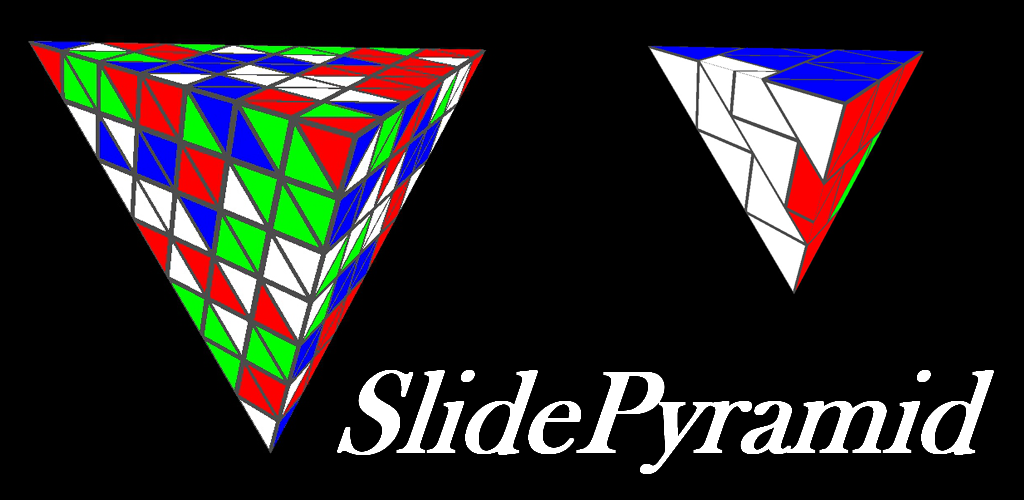
ver. 1.00 (2015.12.12)
Playing enough with SlideCube puzzle and finding solution for any size (SlideCube puzzle appeared to be easier than Rubic's Cube), I asked myself - what about other shapes?
Projects
Here I'm placing homemade projects that was performed mostly as a training in some new areas
For proffesional projects please refer to my resume at the bottom of main page
PcmDump (android application)

SlidePyramid (android version)

ver. 1.00 (2015.12.12)
Playing enough with SlideCube puzzle and finding solution for any size
(SlideCube puzzle appeared to be easier than Rubic's Cube), I asked myself - what about other shapes?
Just for fun I decided to create similar puzzle for pyramide shape. As a result I get SlidePyramid. Control method is same as in the SlideCube. You can define triangle and direction moving by two taps - tapping first to the square you want to move, and second tapping to the place you want to move. You can also rotate entire pyramide in any direction in order to analyze current state of the pyramid.
Here you will find first secret. By intuition (especially for those who had experience with Rubic's Pyramid) it is expected that triangle sliding will appear by the same principle as in Rubic's Pyramid - parallel to the pyramid faces. But no! When moving band of triangles is wrapping to another side it appears, that wrapping direction is different, not that direction that inteitively expected.
When writing the game I made pyramide prototype from the paper (preparing evolvent on a computer and printing it - 5-minutes job), and tried to wrap band of paper around pyramid. I found that it is wrapped parallel to the pyramid edge! That's the discovery! Totally different from Rubic's Pyramid! It became more interesting to finish puzzle writing in order to see, waht kind of solution it can be in this case? And when starting to play with the gane I found that new stule of triangle moving is not stowed to the head immediately. That's really grasping your interest more!
For this moment I found solution for pyramid of size 2. Common algorithm is still unknown.
Final goal is same - make sides of the cube uniformly coloured. Н Start game by pressing "New Game" item in menu. You can change size of the cube choosing "Pyramid Size" menu item. Sliding speed is changed in "Settings" menu item.
Additionally I added wrapping style to the "Settings" menu. "Classic style" wraps triangle to another side smoothly. "Transformer style" immediately rotates entire triangle to another side, that makes triangle moving appearance more attractive sometime :-).
You can download
SlidePyramid here.

You can download SlideCube here.
Short matching guide is here.

TV signal generator
This project was developed as FPGA programming training.
Additionally that time I needed simple and portable TV generator during
my previous job.
TV generator is based on CPLD EPM3064ALC44 from Altera company. It
generates black-and-white TV signal
that satisfies standard used in former Sovietunion (As I remember, it
is B/G standard).
Set of generated signals includes: brightness bars from black to white,
coordinate nets, chess field.
Signals can be switched by button "Mode". Image can be inverted by
button "Inv".
In the archive below you will find schematics and Verilog code.
Note, that this schematics can be used as reference, but not as ready
to use one. You should add
decoupling capacitors. Pin numbers can differ after project is
compiled. Additionally, you should adjust
summing resistors for B, G, R and Sync signals. Unfortunately, now I
have no prototype
and I forgot exact values.
Project documentation (Schematics, Verilog code, timing parameters)
|
|
|
|
|
|
|
|
|
|
|
|
Color TV generator in PAL system
This project is extension of previous one. Here I tried to
develop color TV signal generator
using the same chip. additionally external 8.86MHz generator for color
carrier frequency is required.
Unfortunately, due to simplicity, there are several things not
satisfying to standard. The carrier frequency is not locked on begin of
every raw. (On professional monitors you can see color signal to "run"
in vertical direction).
Color signal is sampled on 16 levels only.
Idea of this simple color signal generating was borrowed from journal
"Radio" [1].
Note, that this schematics can be used only as reference. You should
adjust
summing resistors for B, G, R and Sync signals. Additionally you should
adjust resistors forming DAC for color signal.
Unfortunately, now I have no prototype and I forgot exact values.
File "tvcolorbars.v" consist original project, and in file
"tvcolorbars_colorfields.v" I tried to
extend functionality of TV color generator by adding blue, green, red
colors and their combinations fields.
Switching between signals can be made by "Mode" button.
Project documentation (Schematics, Verilog code)
|
|
|
Reference
[1]. Yablonsky O. Encoder PAL. Radio, 1992, N8, pp.37-39
Links to Similar Projects: